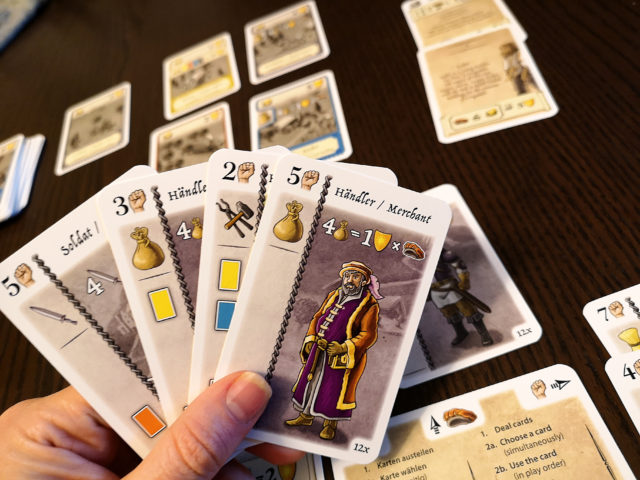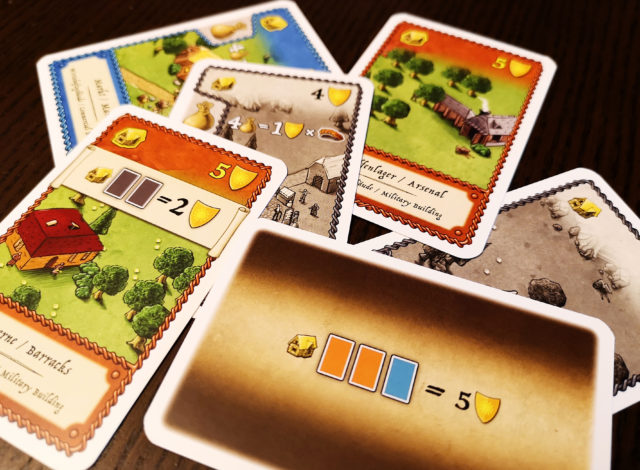When I first tried Oh My Goods it was (I believe) my first BGGcon, and I tried the original German release, “Royal Goods”. I was thrilled by everything going on in the game, and it was absolutely a game that made me fall for Alexander Pfister as a designer. While I haven’t reviewed it here (you can read David’s thoughts on Oh My Goods and the Longsdale in Revolt expansion), I did go on to discover another fabulous card game by Pfister, Port Royal. If you’re curious about that snappy little push your luck game, my thoughts are here. All this is to say – I was incredibly excited when I heard there was another game coming in this same Oh My Goods/Longsdale world. I originally tried a German version of Tybor der Baumeister from the Essen Spiele game fair and was immediately on board with the ways it used cards and the game was not overly long, yet had a lot packed in there.

While it shares the multi-use cards and tableau building aspects with Oh My Goods and Port Royal, Tybor the Builder (as it is in the English release) stands on its own with the card drafting as the driver of the game. Played over 4 rounds, every turn consists of drafting a card for playing into your tableau until all players have empty hands and end-of-round scoring occurs. At the end of the game, there will always be a set of the same scoring categories from game to game, but a “chapter” card that determines something a little different. This is where the story of Longsdale comes into the game, with a small blurb on each of these 8 chapter cards giving some flavour to where you’re at in Tybor’s history. A chapter card is combined with one of four randomly selected “scenario” cards, which will determine the aforementioned end-of-round scoring, which will escalate as the game progresses – more pre-requisites required for more points as you go. Perhaps the mayor is hoping that folks will get on board to build a lot of buildings to entice citizens, or there’s a desire for a variety of townspeople to populate Longsdale – or more specific requests like a strong amount of workers, or a large grouping of captains, and such, as the chapter cards demand. The mix of chapter cards and scenarios is a great feature to keep things fresh for repeat plays of the game, offering enough variety in strategy without changing things up too drastically.
Over the 4 rounds of the game, each player builds their tableau around an overview card, which indicates where cards are built for certain uses – the great part is, these each have a different end-game bonus for scoring based on a particular combination of building colours, which allows each player to work away at something at least a little secret. Every turn during your round consists of selecting a card for play, using it in one of three ways and then passing the rest of your hand on until you’re all out of cards. First, you can play it to the right of your overview card for its value in workers. Next, you can play it above the objective card to become a citizen – merchants, farmers, craftsmen, priests, solider and captains are who you’ll encounter – not only for their game-end scoring of symbols (5 points for every 3 wheat symbols, 5 points for just having a priest at all, and the like) but for the discounts they will provide for buildings (coloured card symbols on their left-hand side). And of course, building something is your last of the 3 options – here, you’ll discard your chosen card and discard the appropriate amount of workers required for the round you’re in, in order to select a building from a central pool. Citizen discounts come in here, decreasing the number of workers you’ll need to construct a building (hey, it pays to have the right folks in your town at the right time!). Buildings may provide game-end points, and also help towards achieving your secret objective card goal!

Overall, the game boils down to 20 decisions – it’s not an over-complicated game. There is a real cleanness to the actions you can take, given that you’re just working with three types of card uses; knowing that there are finite choices for you to take helps players hone in on combinations of cards and what to aim for throughout the game, as there are clear goals you’re aiming for, given the end-of-round scoring specifications. Player interaction tends to be limited, but it’s not entirely a multiplayer solitaire kind of game. Card drafting by its nature has you thinking about what you’ll be passing onto your opponents and what’s good for you and them; not only that, you’re hoping to get in sooner than opponents to get the juicier buildings – or maybe there’s just one of a certain colour that you’re really after so you have to keep an eye on what’s going on so you’re not left behind. There’s some majority scoring throughout the game depending on your scenario, and at the end of the game if you’ve ended up with more of a colour of building than others, so you can’t ignore what’s going on at the table or you’ll end up likely missing out on points.

Where Oh My Goods looks a little more at resource production to drive the game, building up a little bit of a tableau engine in Tybor is where it’s at. Due to the multi-pronged approach for what you’re scoring during the game, as well as game end (sets of icons depending on the citizens you have; buildings; secret objective; multiples of buildings, especially the upgraded ones and the like) it will keep you on your toes from round to round, and play to play. Where it really is similar to its spiritual successor is the way it manages to pack the feel of a Euro strategy game into a deck of cards. With Oh My Goods and Tybor on my shelf (and sometimes in my Quiver), I always know I’ve got something quick, that I can sink my teeth into.
—
Tybor the Builder is a card drafting game for 2 – 4 players (or up to 8 with 2 copies), designed by Alexander Pfister & Dennis Rappel with art by Klemens Franz. Published by Lookout Games in North America, it’s in stores now! Thanks to Asmodee North America for sharing the card drafting goodness with us with a review copy of the game.
Comments
No comments yet! Be the first!